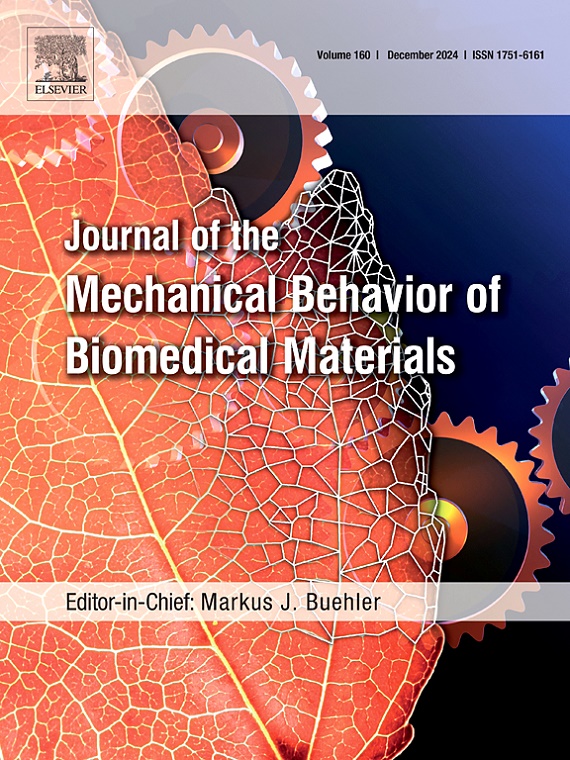Magnesium-substituted zinc-calcium hydroxyfluorapatite bioceramics for bone tissue engineering
IF 3.3
2区 医学
Q2 ENGINEERING, BIOMEDICAL
Journal of the Mechanical Behavior of Biomedical Materials
Pub Date : 2025-02-17
DOI:10.1016/j.jmbbm.2025.106933
引用次数: 0
Abstract
Hydroxyfluorapatite (HFAp) materials possess a structural and compositional similarity to bone tissue and dentin. These bioceramics facilitate various physiological functions, including ion exchange within surface layers. Additionally, magnesium (Mg) serves as a primary substitute for calcium in the biological apatite found in the calcified tissues of mammals, while zinc (Zn) contributes to overall bone quality and exhibits antibacterial properties. Although multiple studies have examined the individual substitution of ions within the hydroxyapatite (HAp) structure, no research to date has investigated the simultaneous substitution of zinc, fluoride, and varying amounts of magnesium in calcium HAp. This study explores the incorporation of magnesium into the structure of zinc-calcium hydroxylfluorapatite. A series of ion-substituted apatites, represented as Ca9.9-xZn0.1Mgx (PO4)6(OH)F with 0 ≤ x ≤ 1, were synthesized. Characterization of the produced samples confirmed that they were monophase apatite, crystallizing in the hexagonal P63/m space group, with only a slight impact on crystallinity due to magnesium doping. Pressure-less sintering of the samples demonstrated that maximum densification, approximately 94%, was achieved at 1200 °C with a sintering dwell of 1 h for the sample with x = 0.1. Furthermore, the Young's and Vickers hardness of this sample reached peak values of 105 and 5.02 GPa, respectively. When immersed in simulated body fluid, the formation of an amorphous CaP which can subsequently be crystallized into crystalline phase on the surface of dense specimens was observed, indicating the ability to bond with bone in a living organism and their potential use as substitutes for failed bone and dentin filling and coating.

骨组织工程用镁取代锌钙羟基氟磷灰石生物陶瓷
羟基氟磷灰石(HFAp)材料具有与骨组织和牙本质相似的结构和成分。这些生物陶瓷促进了各种生理功能,包括表层内的离子交换。此外,在哺乳动物钙化组织中发现的生物磷灰石中,镁(Mg)是钙的主要替代品,而锌(Zn)有助于整体骨骼质量并具有抗菌特性。虽然已有多项研究考察了羟基磷灰石(HAp)结构中离子的个别取代,但迄今为止还没有研究调查了锌、氟化物和不同量的镁在羟基磷灰石钙中同时取代。本研究探讨了镁在锌钙羟基氟磷灰石结构中的掺入。合成了一系列离子取代磷灰石,表示为Ca9.9-xZn0.1Mgx (PO4)6(OH)F,粒径为0≤x≤1。对制备的样品进行表征,证实其为单相磷灰石,在P63/m六方空间群中结晶,镁的掺杂对结晶度只有轻微的影响。样品的无压烧结表明,在1200°C下,x = 0.1的样品烧结时间为1小时,达到了最大的致密化,约为94%。该样品的杨氏硬度和维氏硬度分别达到105和5.02 GPa的峰值。当浸入模拟的体液中时,观察到一种无定形CaP的形成,这种无定形CaP随后可以在致密标本表面结晶成结晶相,这表明了在活体中与骨骼结合的能力,以及它们作为失败的骨和牙本质填充和涂层替代品的潜在用途。
本文章由计算机程序翻译,如有差异,请以英文原文为准。
求助全文
约1分钟内获得全文
求助全文
来源期刊

Journal of the Mechanical Behavior of Biomedical Materials
工程技术-材料科学:生物材料
CiteScore
7.20
自引率
7.70%
发文量
505
审稿时长
46 days
期刊介绍:
The Journal of the Mechanical Behavior of Biomedical Materials is concerned with the mechanical deformation, damage and failure under applied forces, of biological material (at the tissue, cellular and molecular levels) and of biomaterials, i.e. those materials which are designed to mimic or replace biological materials.
The primary focus of the journal is the synthesis of materials science, biology, and medical and dental science. Reports of fundamental scientific investigations are welcome, as are articles concerned with the practical application of materials in medical devices. Both experimental and theoretical work is of interest; theoretical papers will normally include comparison of predictions with experimental data, though we recognize that this may not always be appropriate. The journal also publishes technical notes concerned with emerging experimental or theoretical techniques, letters to the editor and, by invitation, review articles and papers describing existing techniques for the benefit of an interdisciplinary readership.
 求助内容:
求助内容: 应助结果提醒方式:
应助结果提醒方式:


